Illinois, a state teeming with diverse ecosystems, harbors a captivating array of owl species that gracefully navigate its skies.
In this exploration, we delve into the fascinating world of these nocturnal predators, uncovering the secrets of their distinct behaviors, habitats, and roles in the state’s ecological tapestry.
From the majestic Great Horned Owl, a symbol of adaptability, to the diminutive yet resilient Eastern Screech Owl, each species paints a unique portrait on the canvas of Illinois’ biodiversity.
Join us on a journey through the woodlands, prairies, and urban landscapes as we unveil the enigmatic charm and significance of the ten owl species that call Illinois home.
Discover the silent wings that carry tales of nature’s intricacies hidden within the feathers of these wise and elusive creatures. Stay sharp.
10 Owls of Illinois
Discover the enchanting world of owls in Illinois! Each species has its unique charm, from the majestic Great Horned Owl to the elusive Boreal Owl.
Delve into their diverse habitats, feeding habits, and fascinating lifestyles as we explore the intriguing characteristics of these wise and mysterious birds.
1. Great Horned Owl
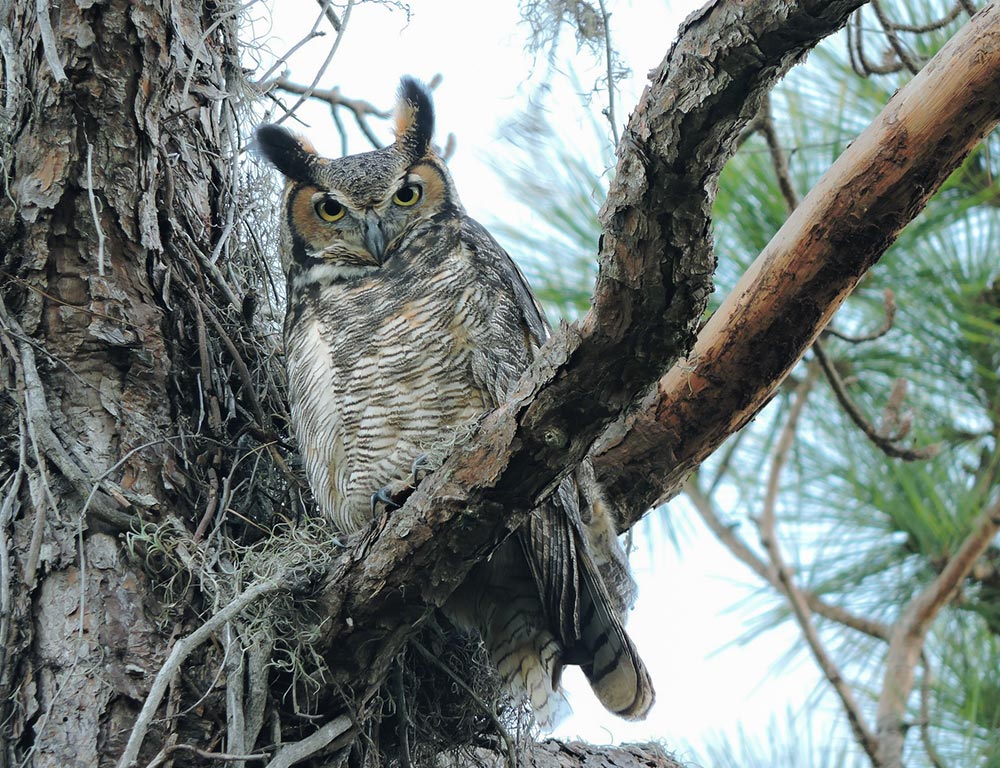
- Scientific Name: Bubo virginianus
- Category: Strigidae (typical owls)
- Population: Common
- Life Span: 5-15 years in the wild
- Size: 18-25 inches
- Weight: 2-5.5 pounds
- Food: Carnivorous; small mammals, birds, and occasionally reptiles
- Wingspan: 3.3-4.8 feet
- Status: Secure
The Great Horned Owl is a highly adaptable and widespread species. Known for its distinctive “horns” (tufts of feathers on its head), it is a powerful predator with keen nocturnal vision.
They are skilled hunters, often capturing prey larger than themselves. Their habitats range from dense forests to urban areas, showcasing their versatility.
These owls are known for their deep hooting calls during the breeding season. Great Horned Owls are solitary, monogamous birds nesting in various locations, including old nests of other large birds.
2. Barn Owl
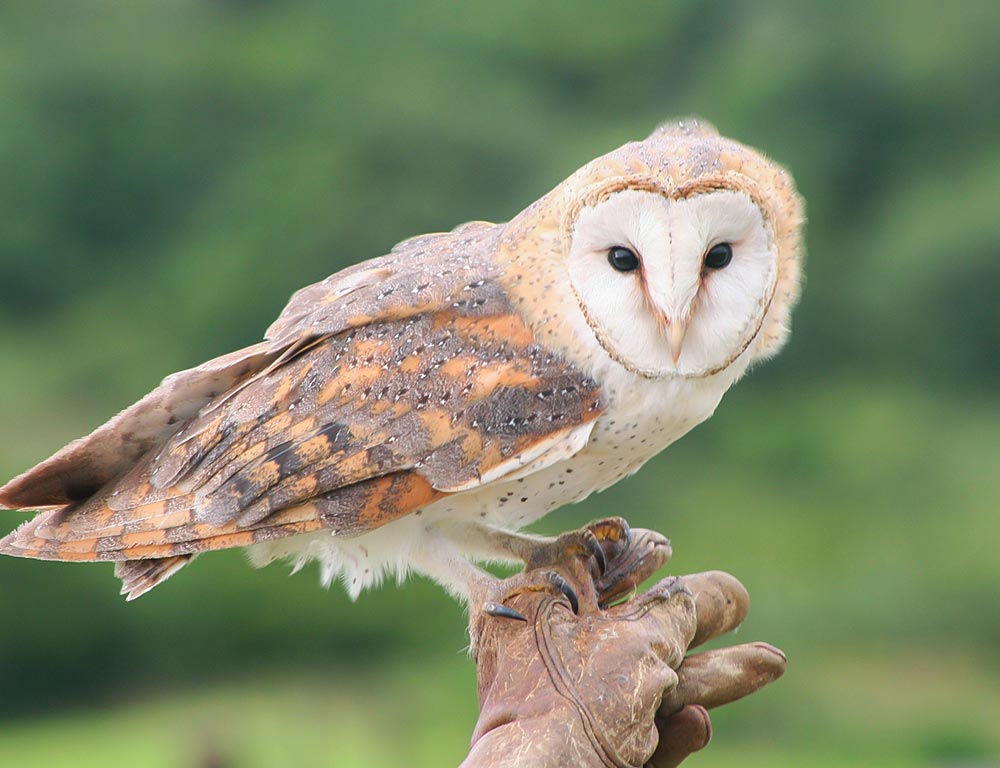
- Scientific Name: Tyto alba
- Category: Tytonidae (barn owls)
- Population: Common
- Life Span: 2-5 years in the wild
- Size: 12-16 inches
- Weight: 0.5-1.4 pounds
- Food: Mainly small mammals, especially rodents
- Wingspan: 3.3-3.8 feet
- Status: Secure
Barn Owls are known for their heart-shaped facial discs and pale plumage. They are excellent rodent hunters, helping to control agricultural pests.
These owls are largely nocturnal and possess exceptional hearing, enabling them to locate prey in complete darkness.
Barn Owls are cavity nesters, often using structures like barns, old buildings, or tree hollows. They are known for their eerie screeching calls; like many owls, they are solitary birds.
3. Barred Owl
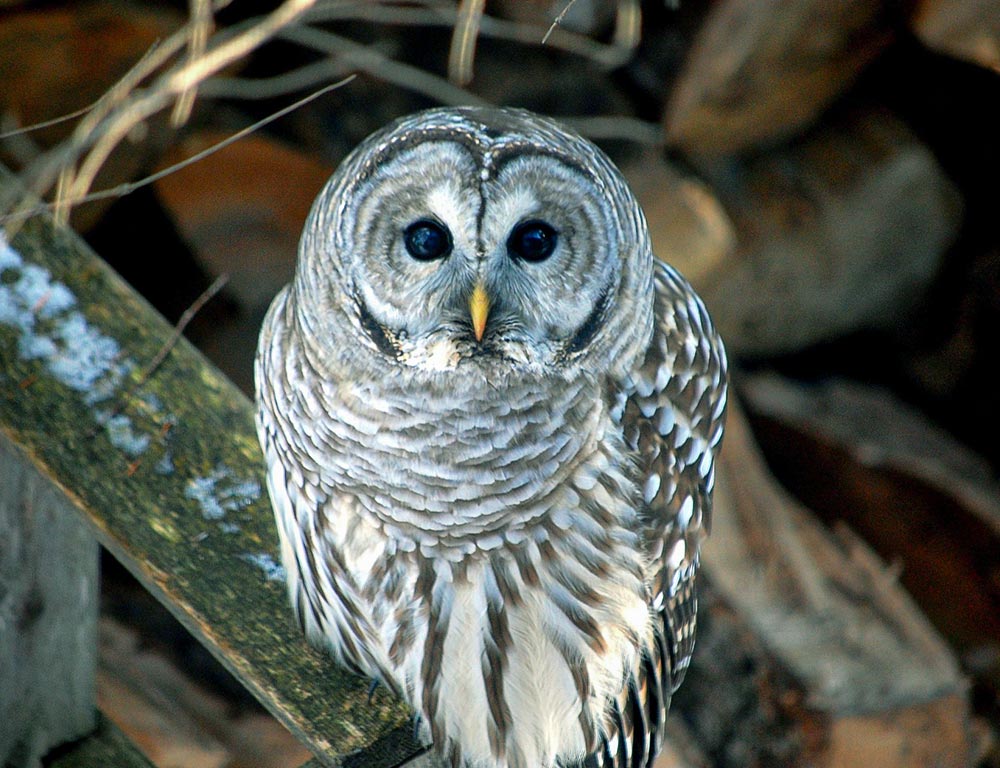
- Scientific Name: Strix varia
- Category: Strigidae (typical owls)
- Population: Common
- Life Span: 10-15 years in the wild
- Size: 16-25 inches
- Weight: 1-2.5 pounds
- Food: Varied diet including small mammals, birds, amphibians, and invertebrates
- Wingspan: 3.2-3.7 feet
- Status: Secure
Barred Owls are known for their distinct barred plumage and large, dark eyes. They are adaptable birds found in various wooded habitats.
Their haunting hooting calls are often heard in the evening. Barred Owls are territorial and generally monogamous.
They nest in tree cavities and, interestingly, may sometimes use abandoned nests of other large birds. Their versatile diet makes them successful predators in diverse environments.
4. Eastern Screech Owl
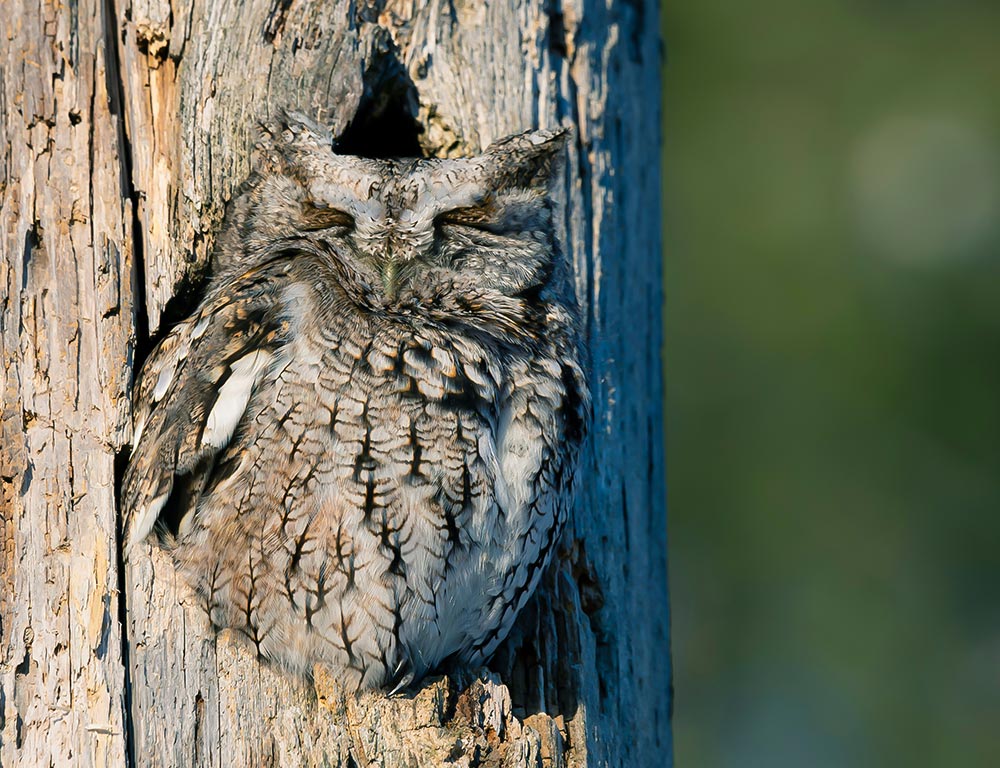
- Scientific Name: Megascops asio
- Category: Strigidae (typical owls)
- Population: Common
- Life Span: 3-14 years in the wild
- Size: 6-10 inches
- Weight: 4-9 ounces
- Food: Primarily insects, small mammals, and birds
- Wingspan: 1.5-2 feet
- Status: Secure
Eastern Screech Owls are small, adaptable birds with excellent camouflage in their surroundings. They come in both red and gray morphs, matching the color of tree bark.
As their name suggests, they produce distinctive trilling and whinnying calls rather than traditional hoots. These owls are cavity nesters, utilizing natural tree holes or nest boxes.
They are skilled hunters, preying on a variety of small creatures. Eastern Screech Owls are known for their ability to coexist with human settlements, often nesting in suburban or urban areas.
5. Snowy Owl
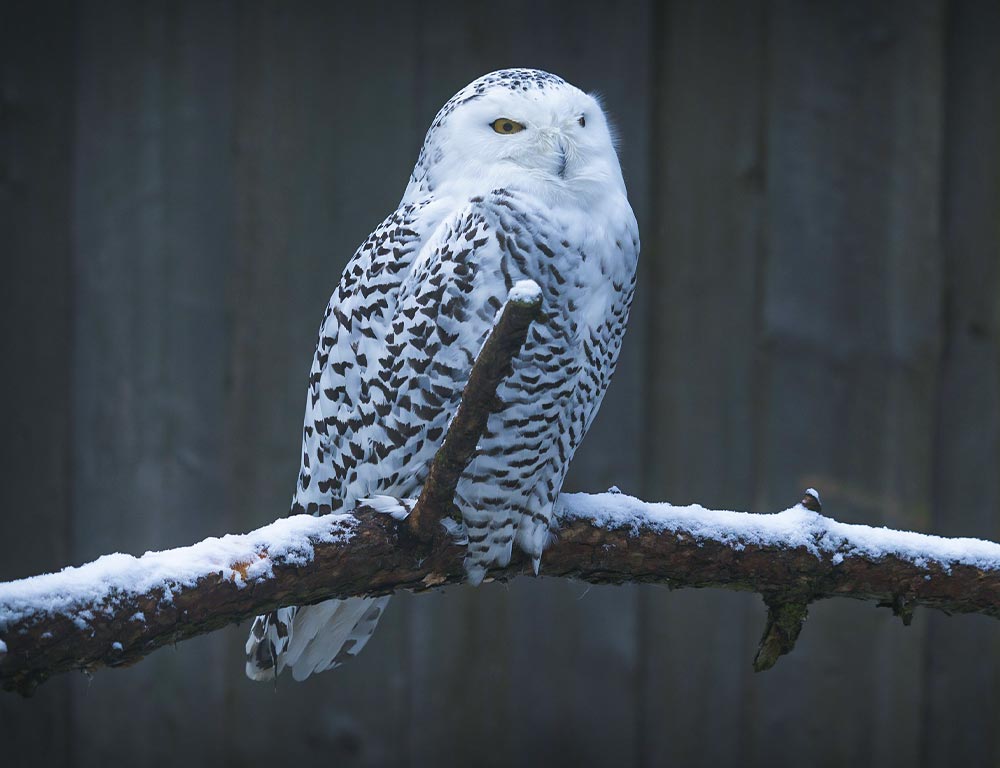
- Scientific Name: Bubo scandiacus
- Category: Strigidae (typical owls)
- Population: Varied, with fluctuations related to prey availability
- Life Span: 10 years in the wild
- Size: 20-27 inches
- Weight: 3-6.5 pounds
- Food: Primarily lemmings, but also birds and mammals
- Wingspan: 4.2-4.8 feet
- Status: Vulnerable in some regions
Snowy Owls are easily recognizable with their predominantly white plumage, a perfect camouflage in the Arctic tundra. They are well adapted to cold environments and are known for long migrations to find food.
These owls are diurnal hunters, making them unique among owls. They primarily feed on lemmings but also consume birds and mammals.
Snowy Owls are nomadic, and their movements are often tied to prey availability. Breeding in the Arctic, they may sometimes venture south during winter, leading to occasional sightings in more southern regions.
6. Short-eared Owl
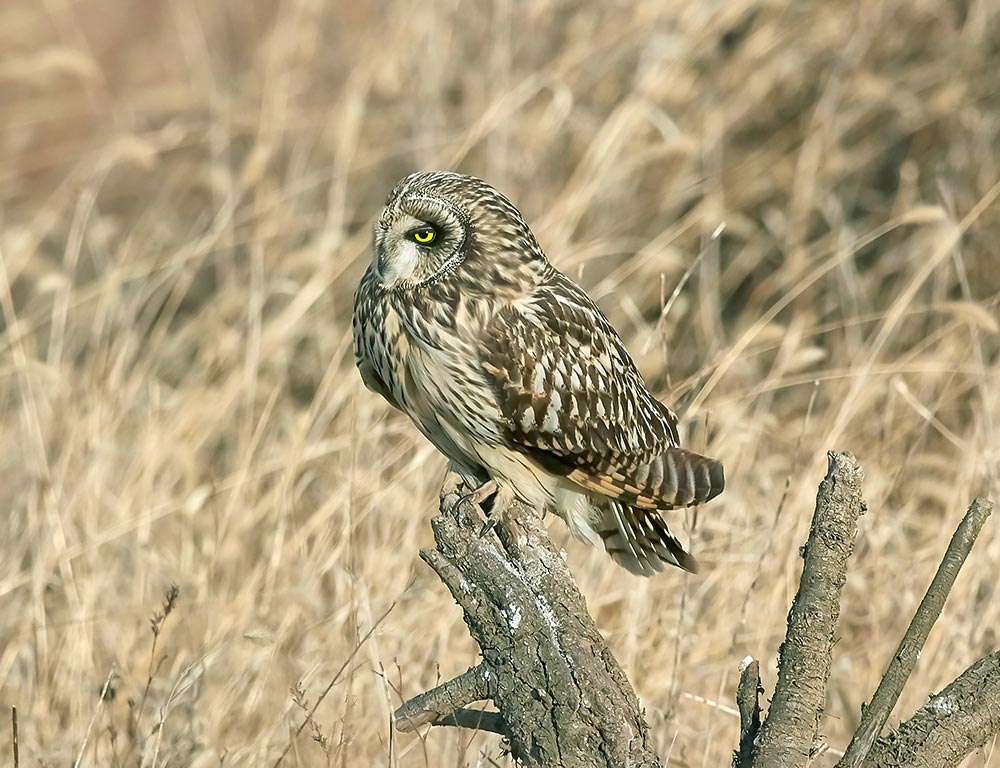
- Scientific Name: Asio flammeus
- Category: Strigidae (typical owls)
- Population: Various populations globally
- Life Span: 3-7 years in the wild
- Size: 13-17 inches
- Weight: 7-17 ounces
- Food: Small mammals, especially voles and mice
- Wingspan: 2.9-3.3 feet
- Status: Secure
Short-eared Owls are medium-sized owls known for their distinctive facial disks and prominent ear tufts. They are crepuscular and often hunt daily, making them more visible than many other owl species.
Their preferred habitats include open grasslands, marshes, and tundra. Short-eared Owls are nomadic and may migrate in response to changes in prey populations.
They are known for their characteristic moth-like flight patterns, with erratic and buoyant movements. Unlike many owls, Short-eared Owls are social during the non-breeding season and can sometimes be found in loose colonies.
7. Long-eared Owl
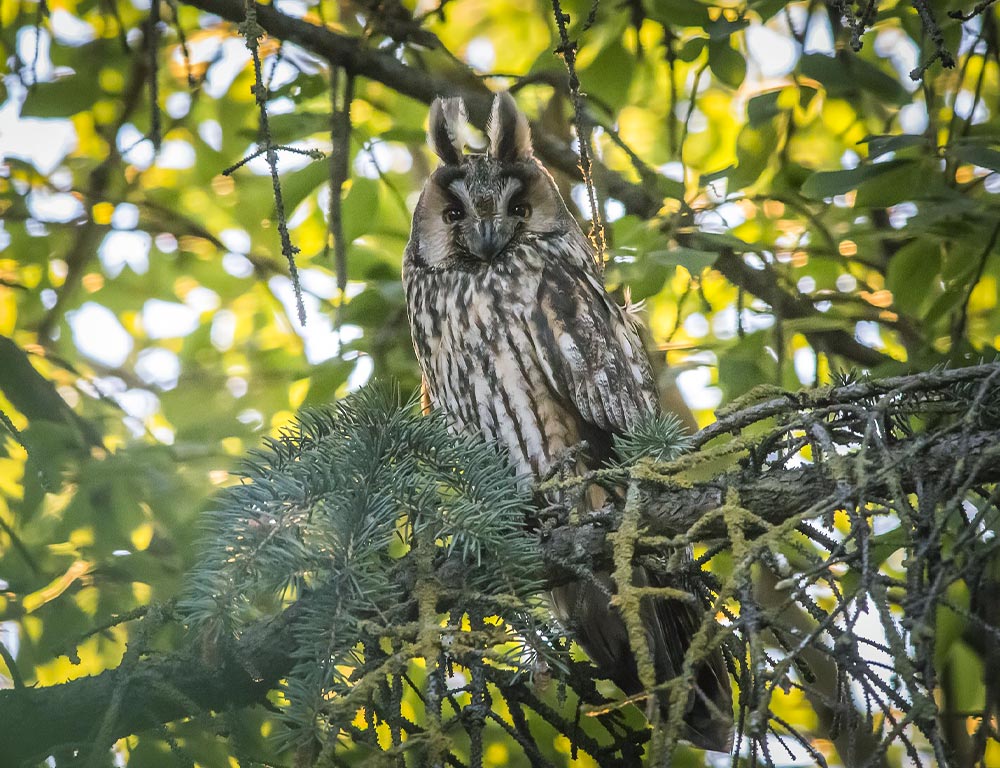
- Scientific Name: Asio otus
- Category: Strigidae (typical owls)
- Population: Varied, with regional fluctuations
- Life Span: 4-10 years in the wild
- Size: 13-16 inches
- Weight: 7-16 ounces
- Food: Primarily small mammals, occasionally birds
- Wingspan: 3.3-3.6 feet
- Status: Generally secure
Long-eared Owls are medium-sized owls with long ear tufts that give them a distinctive appearance. They are primarily nocturnal hunters, preying on small mammals like voles and mice.
These owls are often found in woodlands, coniferous forests, and areas with dense vegetation where they can roost during the day. Long-eared Owls are known for their cryptic plumage, providing excellent camouflage.
They are generally solitary but may congregate in loose groups during the winter. Their hooting calls are less pronounced than those of other owl species, and they communicate with various vocalizations.
8. Northern Saw-whet Owl
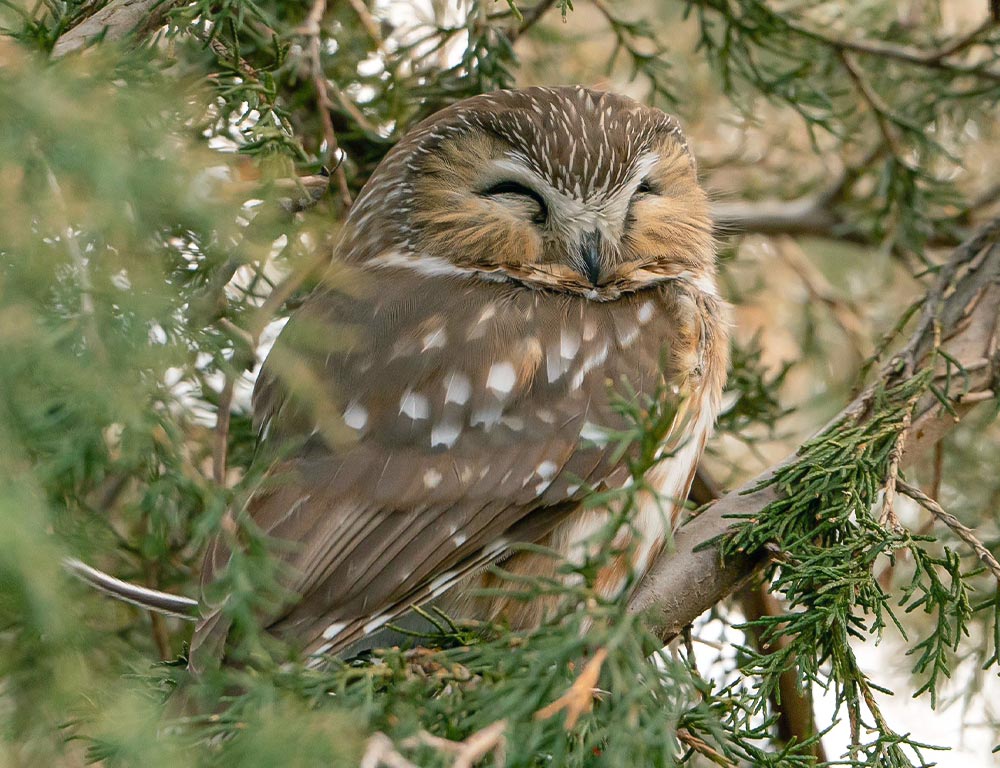
- Scientific Name: Aegolius acadicus
- Category: Strigidae (typical owls)
- Population: Various populations, generally stable
- Life Span: 3-7 years in the wild
- Size: 7-8 inches
- Weight: 2-5 ounces
- Food: Mainly small mammals, insects, and small birds
- Wingspan: 16-18 inches
- Status: Generally secure
The Northern Saw-whet Owl is a small, secretive owl with a distinctive call that resembles the sound of a saw being sharpened. Despite its size, it is a formidable predator, preying on small mammals, insects, and occasionally small birds.
These owls are primarily nocturnal and prefer dense coniferous or mixed forests for roosting and nesting. They are cavity nesters, utilizing abandoned woodpecker holes or natural tree cavities.
Northern Saw-whet Owls are migratory, and their movements can be influenced by fluctuations in prey populations. Despite their widespread distribution, they are often overlooked due to their secretive nature.
9. Burrowing Owl
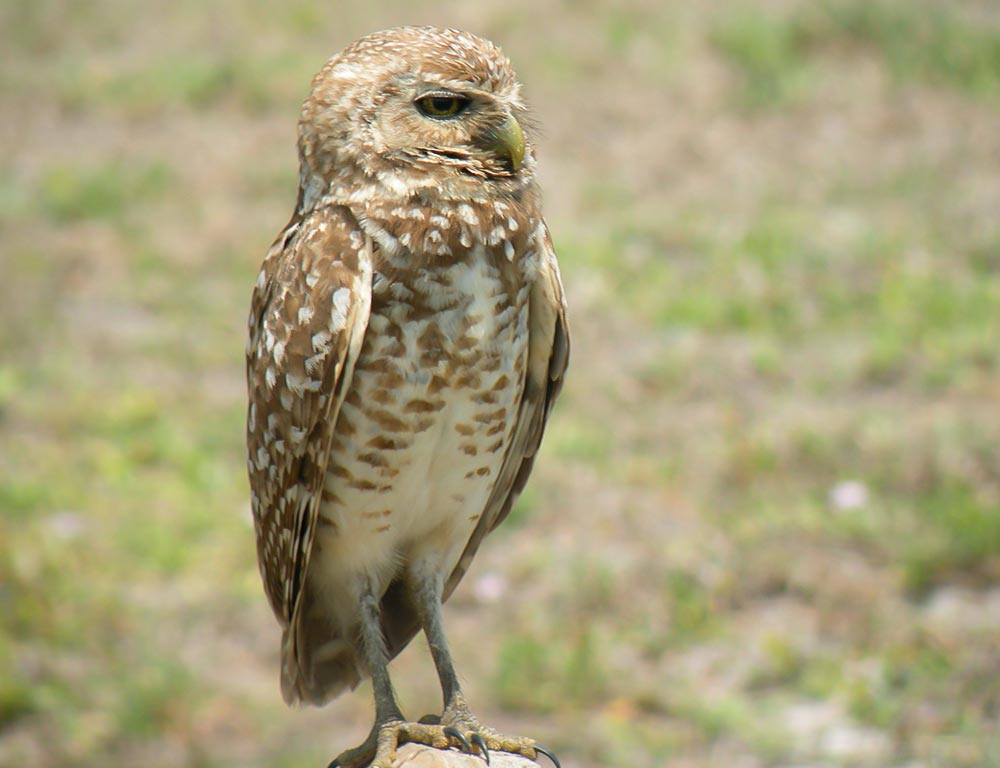
- Scientific Name: Athene cunicularia
- Category: Strigidae (typical owls)
- Population: Varied, declining in some regions
- Life Span: 6-8 years in the wild
- Size: 7.5-10 inches
- Weight: 5-8 ounces
- Food: Primarily insects, small mammals, and birds
- Wingspan: 21-24 inches
- Status: Concern in some regions
Burrowing Owls are unique among owls for their open habitats and ground-nesting preference. They are often found in grasslands, prairies, and deserts.
As their name suggests, they use burrows, typically created by mammals like ground squirrels, for nesting. They are diurnal hunters, actively foraging during the day for insects, small mammals, and birds.
Burrowing Owls are known for their distinctive bobbing head movements. Unfortunately, they face threats such as habitat loss, pesticide exposure, and collisions with vehicles, leading to declining populations in certain areas.
10. Boreal Owl
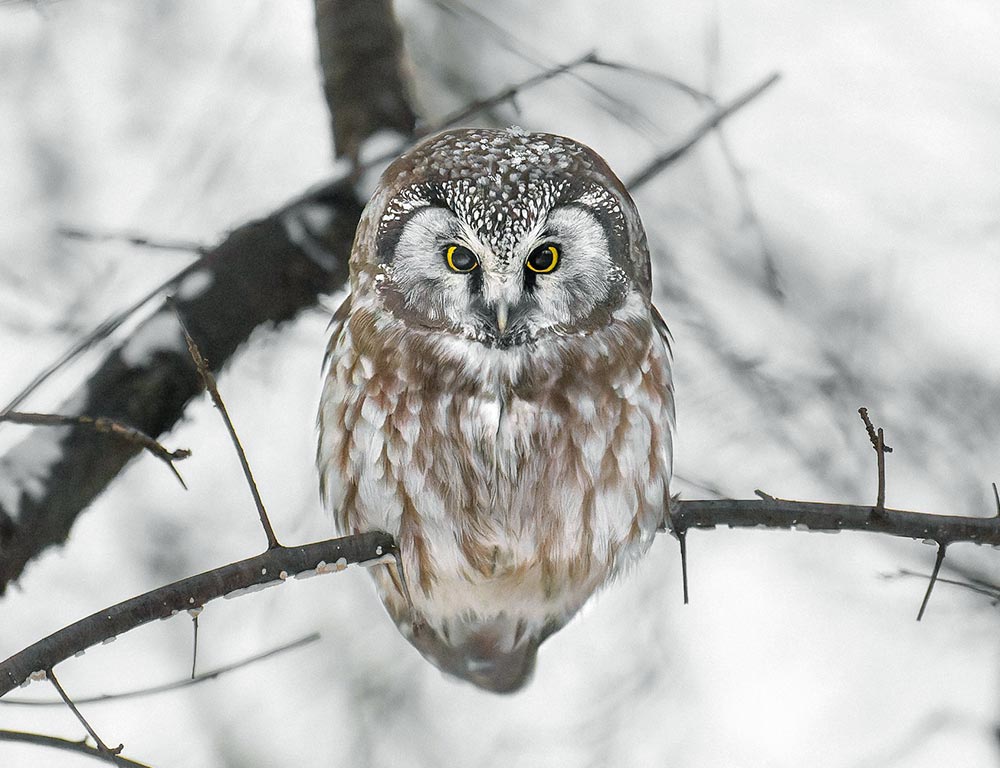
- Scientific Name: Aegolius funereus
- Category: Strigidae (typical owls)
- Population: Varied, with regional fluctuations
- Life Span: 3-7 years in the wild
- Size: 9-11 inches
- Weight: 3-7 ounces
- Food: Small mammals, birds, and insects
- Wingspan: 21-24 inches
- Status: Generally secure
The Boreal Owl is well-adapted to northern boreal forests, where it prefers dense coniferous habitats. Despite its small size, it is an efficient predator, capturing prey such as small mammals, birds, and insects.
Boreal Owls are primarily nocturnal, with a distinctive haunting call. They nest in tree cavities and are known for using old woodpecker holes.
These owls are generally solitary and may cover large territories. Boreal Owls are also known for irruptive movements, where they migrate southward in search of food during certain years, influenced by fluctuations in their prey populations.
How to Increase the Number of Owls in Illinois?
Unraveling the mysteries of nature often involves efforts to preserve and enhance the populations of unique species.
In Illinois, where the presence of owls adds to the ecological richness, fostering an environment conducive to their growth becomes imperative.
Here are some of the substantial points to consider in the quest to increase the number of owls in the state.
- Habitat Preservation and Restoration: Preserving existing owl habitats and restoring degraded areas ensures the availability of suitable environments for nesting, roosting, and hunting.
- Nest Box Programs: Implementing nest box programs can provide additional nesting sites, especially for cavity-nesting owls like the Eastern Screech Owl and Northern Saw-whet Owl.
- Mitigating Human-Wildlife Conflicts: Addressing conflicts between owls and human activities, such as urbanization and agriculture, through education and responsible development practices is crucial.
- Rodent Population Management: As many owl species feed on rodents, managing rodent populations in agricultural areas can indirectly support owls by ensuring a stable prey base.
- Reducing Light Pollution: Minimizing light pollution helps maintain the natural darkness required by owls for hunting and reduces disturbance to their nocturnal behaviors.
- Community Engagement and Education: Engaging local communities in owl conservation efforts through education programs, workshops, and citizen science initiatives fosters a sense of responsibility and active participation.
By addressing these facets, Illinois can cultivate an environment that sustains current owl populations and encourages their growth, contributing to the state’s biodiversity and the overall health of its ecosystems.
Wrapping Up
In the ethereal nights of Illinois, the silent wings of owls weave tales of ecological balance and enchantment.
Upholding their presence demands a collaborative effort, a harmonious blend of habitat conservation, thoughtful urban planning, and community involvement.
As we strive to increase the number of owls in Illinois, our commitment to preserving natural spaces, mitigating human-wildlife conflicts, and fostering understanding becomes paramount.
By embracing responsible practices, we safeguard these majestic creatures and nurture a thriving ecosystem where owls play an integral role.
The hoots echoing through Illinois’ landscapes tell a story of resilience, adaptation, and the delicate dance between nature and humanity. Thank you very much.